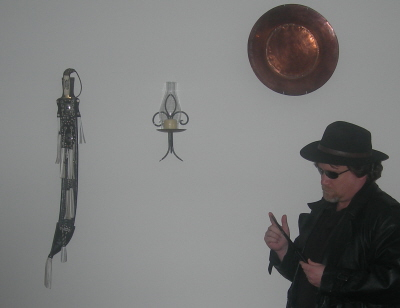|
About This Author
Come closer.
|
Complex Numbers
Complex Numbers
A complex number is expressed in the standard form a + bi, where a and b are real numbers and i is defined by i^2 = -1 (that is, i is the square root of -1). For example, 3 + 2i is a complex number.
The bi term is often referred to as an imaginary number (though this may be misleading, as it is no more "imaginary" than the symbolic abstractions we know as the "real" numbers). Thus, every complex number has a real part, a, and an imaginary part, bi.
Complex numbers are often represented on a graph known as the "complex plane," where the horizontal axis represents the infinity of real numbers, and the vertical axis represents the infinity of imaginary numbers. Thus, each complex number has a unique representation on the complex plane: some closer to real; others, more imaginary. If a = b, the number is equal parts real and imaginary.
Very simple transformations applied to numbers in the complex plane can lead to fractal structures of enormous intricacy and astonishing beauty.
February 6, 2023 at 12:01am February 6, 2023 at 12:01am
| |
To start with, I'll note that this is a book promotion. That's okay; it's at least somewhat informative.
This Is Your Brain on Architecture 
In her new book, Sarah Williams Goldhagen presents scientific evidence for why some buildings delight us and others—too many of them—disappoint.
Because architecture is art, and some art delights us and others disappoint?
(I know an argument can be made that architecture isn't actually art because architecture has a function, but it still has a huge artistic component.)
One last note before I dive in: the article is from 2017. That shouldn't make much difference, but it references a "new" book, which simply wouldn't be the case after six years.
Sarah Williams Goldhagen was the architecture critic for The New Republic for many years, a role she combined with teaching at Harvard University’s Graduate School of Design and elsewhere. She is an expert on the work of Louis Kahn, one of the 20th century’s greatest architects, known for the weighty, mystical Modernism of buildings like the Salk Institute in La Jolla, California, and the Bangladeshi parliament in Dhaka.
At the top of the linked page is a photograph of the Salk Institute. I'm no expert on architectural labels, but that building looks more Brutalist than Modernist. Perhaps it is both.
Several years ago, Goldhagen became interested in new research on how our brains register the environments around us. Dipping into writing from several fields—psychology, anthropology, linguistics, and neuroscience—she learned that a new paradigm for how we live and think in the world was starting to emerge, called “embodied cognition.”
And this is why the article appeals to me: not necessarily because of the architectural slant to it, but because it features multidisciplinary science. Well, sort-of science; I'll get to that.
“This paradigm,” she writes in her magisterial new book, Welcome to Your World: How the Built Environment Shapes Our Lives, “holds that much of what and how people think is a function of our living in the kinds of bodies we do.” Not just conscious thoughts, but non-conscious impressions, feedback from our senses, physical movement, and even split-second mental simulations of that movement shape how we respond to a place, Goldhagen argues.
I mean... okay. I don't think that's a new concept, though. It wasn't a new concept in 2017. Perhaps it wasn't framed exactly like that before, but I spent my career working with architects, and I have the impression that they all think that way.
The research led Goldhagen to science-based answers for previously metaphysical questions, such as: why do some places charm us and others leave us cold? Do we think and act differently depending on the building or room we’re in?
The first question is a valid line of inquiry, in my opinion. The second should be blindingly obvious to anyone.
Architects intuited some of these principles long ago. As Kahn once noted of the monumental Baths of Caracalla in Rome, a person can bathe under an eight-foot ceiling, “but there’s something about a 150-foot ceiling that makes a man a different kind of man.”
Like I said, they all think that way (well, all the ones I've met; I should guard against sweeping generalizations). The question I have is: can it be quantified? That would make this legitimate science.
As an example from my own field, consider a road. If you're driving down a country road that has 9-foot lanes with trees just off the edge, it feels different, and you'll drive differently, than if you're on a 12-foot-lane interstate with a lot of clear space past the shoulder, even if both roads are straight and level. The psychology of this has been quantified, and it's in the realm of science. Similarly, we know we feel different in a large bedroom (for example) than we do in a small one, but has that been quantified? What's the optimal size of a bedroom, considering this psychology, and how do different people react to different sizes?
The article jumps into an interview with the book's author:
At the time, there really was no intellectual paradigm for thinking about these questions. And then about 15 years ago, my husband handed me a book by someone who had written a previous book he had really liked. The title of the book was Metaphors We Live By. It’s co-authored by George Lakoff, who’s a cognitive linguist, and Mark Johnson, who’s a philosopher. The basic argument is that much of how our thought is structured emerges from the fact of our embodiment. And many of the ways those thoughts are structured are metaphorical.
Honestly, I'd rather read that book than the one this page is promoting. Not that I wouldn't want to read this one; it's a matter of priority.
One of the things I found was that, basically, [given] what we now know about human cognition and perception, the built environments we inhabit are drastically more important than we ever thought they were.
Okay, that's worth explaining in a book, I think. And it passes my sniff test.
Architects tend, particularly with parametric design, to emphasize overall aggregate form, and all that other stuff gets filled in later. And then, very often, it’s value-engineered out.
I understand the need for value engineering, but I despise the concept. One time, a site plan I did lost a drainage grate to value engineering, and then everyone wondered why the street started flooding every time it rained, and I got the blame until I pointed out that the drain I'd designed never got built. I'm not saying I was always right, but I've never put in a drainage device without reason.
Another thing is differentiated, non-repetitive surfaces. [The psychologist and author] Colin Ellard did a study of how people respond: He basically put sensors on people and had them walk by a boring, generic building. Then he had them walk past something much more variegated with more ways to [engage] visually and therefore motorically. He found that people’s stress levels, measured by cortisol, went up dramatically when they were walking past the boring building.
Okay, see, that's quantification. Science. It may have been a good study or it may not; I don't have the data. But it's on the right track.
The rest of the interview is worth reading, I think, because she raises some important points. But I'm not going to nitpick them (which is not to say that I completely agree), so no point in reproducing it here. Link's up there if you're interested. |
© Copyright 2025 Robert Waltz (UN: cathartes02 at Writing.Com). All rights reserved.
Robert Waltz has granted InkSpot.Com, its affiliates and its syndicates non-exclusive rights to display this work.
|

